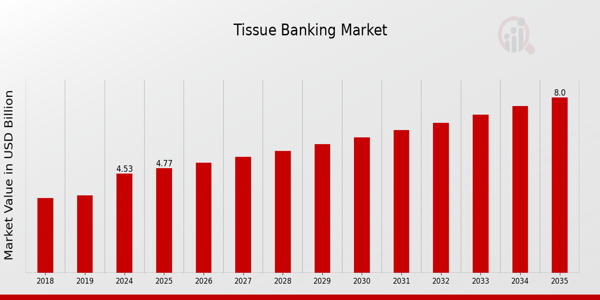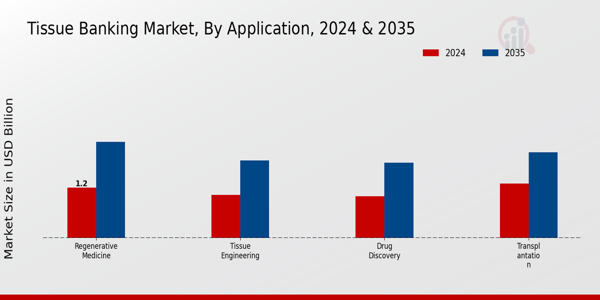Tissue Banking Market Overview
As per MRFR analysis, the Tissue Banking Market Size was estimated at 4.3 (USD Billion) in 2023. The Tissue Banking Market is expected to grow from 4.53 (USD Billion) in 2024 to 8 (USD Billion) by 2035. The Tissue Banking Market CAGR (growth rate) is expected to be around 5.31% during the forecast period (2025 - 2035).
Key Tissue Banking Market Trends Highlighted
A number of important market factors are propelling the substantial rise of the Tissue Banking Market. The need for efficient tissue storage and retrieval solutions has increased due to a number of variables, including the growing incidence of chronic illnesses and the growing demand for organ transplants.
Furthermore, tissue banks are now more dependable and easily available due to improvements in their capacities and efficiency brought about by biobanking technology breakthroughs.
Growing research expenditures and biotechnological advancements are also driving these advances, as governments and organizations throughout the world realize how crucial tissue banks are to the advancement of medical research.
Expanding partnerships between the public and private sectors to improve research capacity is one opportunity to investigate in the Tissue Banking Market. Another area with room for expansion is personalized medicine, where customized treatments made from biomaterials kept in tissue banks may be developed to suit the requirements of specific patients.
Research prospects may be further increased by this partnership, which may increase the availability of a variety of biological materials. Recent trends show that biobanking processes are moving toward higher ethical standards and regulatory compliance. As players work to adhere to strict regulations for the use, processing, and storage of human tissues, the sector is undergoing changes.
Better specimen tracking and analysis are also made possible by the growing significance of integrating digital technology with data management systems. All things considered, these patterns show a strong development in the Tissue Banking Market, setting it up for future expansion and improved contributions to medical research and healthcare.

Source: Primary Research, Secondary Research, Market Research Future Database and Analyst Review
Tissue Banking Market Drivers
Increasing Demand for Regenerative Medicine
The Tissue Banking Market is significantly driven by the surging demand for regenerative medicine, which has gained traction due to advancements in cell therapy and tissue engineering. A report from the National Institutes of Health indicates that the regenerative medicine market is projected to exceed USD 50 billion by 2025, showcasing a compounded annual growth rate of over 23%.
This tremendous growth is fueled by increasing investments in Research and Development by prominent organizations, such as the European Society of Gene and Cell Therapy, which has seen over 30 ongoing clinical trials in tissue engineering and regenerative medicine.
Furthermore, the World Health Organization supports initiatives in regenerative medicine that address critical healthcare challenges, especially in regions facing aging populations and chronic disease burdens. The expansion of tissue banks plays a critical role in the development of therapies that utilize stem cells and other tissues to treat conditions that currently have limited treatment options.
Technological Advancements in Preservation Techniques
Another significant driver for the Tissue Banking Market is the technological advancements in preservation methods. Innovations such as automated cryopreservation and advanced biobanking equipment have improved the efficiency and quality of tissue preservation.
A study conducted by the American Association of Tissue Banks reveals that the use of innovative cryoprotectants can enhance cell viability rates by up to 90% in preserved tissues.
Furthermore, organizations like the International Society for Biological and Environmental Repositories promote best practices and technological improvements in preservation, directly supporting the growth of tissue banks worldwide. The enhanced preservation techniques allow for a wider range of tissues to be banked and utilized in research and therapeutic applications, thus driving growth in the sector.
Increased Focus on Personalized Medicine
The Tissue Banking Market is also propelled by the rising emphasis on personalized medicine, which tailors treatment to individual patient profiles based on genetic data. As healthcare systems shift towards personalized approaches, the demand for biobanks that provide patient-specific tissue samples has significantly increased.
According to a report by the National Cancer Institute, personalized medicine could reduce the cost of cancer treatments by an estimated 40% in the next decade.
Leading organizations, such as the Pharmacogenomics Knowledge Base, emphasize the importance of tissue banks in facilitating research aimed at understanding patient variability in drug response. This niche focus on personalized treatment options is driving tissue banking activities, thereby expanding the market.
Supportive Government Initiatives and Funding
Supportive government initiatives and funding play a critical role in fostering the growth of the Tissue Banking Market. Various countries are implementing policies aimed at enhancing biobanking resources, promoting research and ethical practices in tissue donation.
For example, the U.S. Department of Health and Human Services has allocated increased funding for biobanking projects in its annual budgets, significantly impacting tissue collection and research capabilities.
Moreover, the European Commission actively supports tissue banking through its Horizon 2020 program, which funds collaborative research and innovation projects aimed at improving tissue utilization. These governmental supports not only boost the operational capabilities of tissue banks but also encourage the development of new therapies, thereby contributing to market growth.
Tissue Banking Market Segment Insights
Tissue Banking Market Application Insights
The Tissue Banking Market experienced notable growth, driven by various applications across multiple sectors, particularly in regenerative medicine, drug discovery, tissue engineering, and transplantation.
One of the most significant applications, regenerative medicine, was valued at 1.2 USD Billion in 2024, rising to 2.3 USD Billion in 2035, thereby demonstrating a robust increase in its relevance and demand. This segment was vital as it focused on repairing, replacing, or regenerating damaged tissues, significantly impacting patients' quality of life.
Drug discovery was another important application within the Tissue Banking Market, with a value of 1.0 USD Billion in 2024, expected to grow to 1.8 USD Billion by 2035. Such growth was essential, as this application provided researchers with critical biological materials necessary for developing and testing new drugs.
Similarly, the tissue engineering application, valued at 1.03 USD Billion in 2024 and anticipated to reach 1.85 USD Billion in 2035, played a significant role in the creation of biological substitutes designed to restore, maintain, or improve tissue function, thus holding great potential in surgical procedures and clinical treatments.
Lastly, the transplantation segment stood as a significant contributor, with a valuation of 1.3 USD Billion in 2024 and projected to grow to 2.05 USD Billion by 2035, reflecting the increasing need for organ and tissue donations to save lives and improve health outcomes.
The Tissue Banking Market segmentation highlighted diverse applications where each contributes distinctly, yet collectively, underlined the growing dependency within the health sectors globally. This landscape was further enhanced by growing advancements in technology and research methodologies that continued to augment the utility of tissue banks in addressing pressing medical needs.
As a major player in healthcare innovation, the tissue banking industry faced challenges such as ethical considerations in sourcing, yet it presented abundant opportunities in areas like personalized medicine and advanced therapeutic interventions, making it a burgeoning field worthy of ongoing investment and focus.

Source: Primary Research, Secondary Research, Market Research Future Database and Analyst Review
Tissue Banking Market Type of Tissue Bank Insights
The Tissue Banking Market has been expanding significantly, reflecting the growing demand for tissue banking services in healthcare. The market encompasses various types of tissue banks, including cell banks, organ banks, and tissue banks, each playing a critical role in biomedical research, regenerative medicine, and transplantation.
Cell Banks are essential for the preservation of cell lines used in research and therapy, ensuring the availability of standardized biological materials. On the other hand, Organ Banks focus on the collection and distribution of organs for transplantation, addressing the critical need for organ donors worldwide.
Tissue Banks, which store various human tissues, facilitate advanced research and clinical applications linked to tissue repair and organ regeneration. The market is driven by increasing investments in Research and Development (R&D) and advancements in storage technologies, but it also faces challenges such as ethical considerations and regulatory compliance.
With the demand for biological materials rising, the Tissue Banking Market positions itself as a critical segment within the healthcare industry, showcasing robust growth potential and opportunities for innovation in tissue preservation and utilization.
Tissue Banking Market Storage Method Insights
The Tissue Banking Market is evolving notably within its Storage Method segment, which showcases a range of techniques vital for the preservation of biological materials. Cryopreservation, known for its ability to maintain cellular integrity over extended periods, plays an essential role in preserving stem cells and reproductive tissues, dominating the landscape due to its efficiency.
Lyophilization, on the other hand, is gaining traction as it effectively reduces the volume of biological samples while maintaining viability for various applications, catering to a growing demand in Research and Development innovations. Chemical Preservation remains crucial as a cost-effective alternative for long-term storage, which appeals to numerous research institutions and biobanks.
This diversification within the Storage Method segment aligns with the upward trend in Tissue Banking Market revenue, driven by increasing requirements in medical research and therapy developments, as well as rising government initiatives aimed at enhancing biobanking infrastructure and capabilities globally.
Overall, the market segmentation emphasizes the significance of different preservation techniques to cater to diverse biological material storage needs, highlighting the interconnected nature of technological advancements and research growth in the field.
Tissue Banking Market End-use Insights
The Tissue Banking Market is experiencing substantial growth, particularly in the End-use segment, which comprises critical areas such as Hospitals, Research Institutions, and Pharmaceutical Companies.
Hospitals play a significant role in this segment, relying heavily on tissue banks for transplantation and surgical procedures. Research Institutions utilize biological samples for extensive studies, enhancing innovations in regenerative medicine and therapeutic approaches.
The importance of Pharmaceutical Companies cannot be understated, as they depend on tissue banks for drug development and testing, leading to breakthroughs in treatments. These segments collectively contribute to a sound Tissue Banking Market revenue, fueled by advancements in healthcare technologies and rising investments in research.
Furthermore, there are ample opportunities in this market, with frequent collaborations between these End-users aimed at improving efficiencies in tissue storage, processing, and distribution, signifying a robust market growth trajectory over the coming years.
Tissue Banking Market Regional Insights
The Tissue Banking Market comprised various regions, each contributing to its overall growth. In 2024, North America led the charge at 1.75 USD Billion, which showcases its majority holding in this market segment.
Europe followed with a valuation of 1.30 USD Billion, reflecting its significant presence. The Asia Pacific region is expected to reach 0.95 USD Billion, indicating a growing adoption of tissue banking technologies.
South America, while smaller, attained 0.30 USD Billion, showing potential for growth, while the Middle East and Africa had a value of 0.23 USD Billion, indicating their emerging role in the tissue banking landscape.
The trends within these regions reflected the growing demand for advanced medical research applications and the increasing prevalence of chronic diseases, making tissue banks critical for research and development.
North America’s dominance was supported by a robust healthcare system and significant investment in Research and Development, while Europe benefited from stringent regulatory frameworks promoting tissue preservation integrity. Overall, the market's growth is driven by technological advancements, increased awareness, and potential applications across various medical fields.

Source: Primary Research, Secondary Research, Market Research Future Database and Analyst Review
Tissue Banking Market Key Players and Competitive Insights
The Tissue Banking Market is a dynamic and rapidly evolving sector, characterized by a variety of players that contribute to the growth and sustainability of biobanks. With advancements in biopreservation techniques, regulatory frameworks, and technological innovations, the competitive landscape is shaped by a blend of established companies and emerging entrants.
As the demand for biological samples grows across research, diagnostics, and therapeutic development, companies are increasingly focusing on enhancing their product offerings, improving operational efficiency, and expanding their geographic reach to capture market share.
Strategic collaborations, partnerships, and mergers are becoming common as firms aim to optimize their capabilities and broaden their service portfolio in response to the escalating needs of the healthcare and biotechnology industries.
Thermo Fisher Scientific stands out in the Tissue Banking Market with its strong focus on biobanking solutions that support clinical research, personalized medicine, and regenerative therapies.
The company's extensive range of products, which includes bioprocessing equipment, storage systems, and molecular biology tools, enhances its ability to meet diverse client needs across different applications.
Thermo Fisher Scientific operates on a global scale, leveraging its extensive distribution network to facilitate accessibility to its innovative technologies in various regions. The company's strengths lie in its commitment to quality and innovation, evidenced by its investment in R&D and its capacity to deliver high-quality products that comply with international standards.
This positions Thermo Fisher Scientific as a frontrunner in the market, enabling it to maintain a solid competitive advantage while addressing emerging challenges in tissue banking.
BioLife Sciences is another significant player in the Tissue Banking Market, known for its sophisticated biopreservation solutions and sample management systems that cater to the needs of researchers and clinicians worldwide.
The company offers a wide array of key products and services, including controlled-rate freezers, temperature monitoring systems, and storage solutions that ensure sample integrity over extended periods.
BioLife Sciences is recognized for its strong market presence, owing to its strategic focus on innovation and customer collaboration. Its strengths include a dedicated approach to quality assurance and the ability to respond swiftly to market demands.
Furthermore, BioLife Sciences has established partnerships and collaborations that bolster its offerings, alongside recent mergers and acquisitions aimed at expanding its technological capabilities and enhancing its global footprint within the tissue banking sector.
This strategic positioning enhances BioLife Sciences’ competitive edge, enabling it to foster growth and respond to the dynamic landscape of the Tissue Banking Market effectively.
Key Companies in the Tissue Banking Market Include
- Thermo Fisher Scientific
- BioLife Sciences
- IQVIA
- PerkinElmer
- Celerion
- Global Biorepository
- Tecan
- American Type Culture Collection
- Miltenyi Biotec
- Tissue Regenix
Tissue Banking Market Developments
Through its LongevityBank subsidiary, CytoMed Therapeutics strengthened its strategy in cord blood-derived biologics in October 2024 by completing the acquisition of a Malaysian cord blood banking license and assets, including cryopreservation equipment, more than 12,000 cord blood units, and real estate facilities.
The same month, BioTissue and LifeLink Tissue Bank established a strategic partnership in which BioTissue transforms placental tissue recovered by LifeLink into surgical and ophthalmic treatments, increasing the use of birth tissue and raising the bar for moral, high-quality transplantation.
By selling two BioArchive cryogenic systems to HealthBanks Biotech Company Ltd. in August 2023, ThermoGenesis increased its market presence in Asia and boosted its storage capacity to 60,000 stem cell units in Taiwan, Hong Kong, Thailand, and the United States. ThermoGenesis also strengthened its position in the market by integrating AXP and BioArchive systems.
In order to move the technology from engineering spec to industrial-scale manufacturing and support late-phase clinical trials in severe burns throughout Europe and Switzerland, Swiss biotech CUTISS teamed up with Tecan on April 14, 2025, to advance automation for the production of denovoSkin, a customized, bilayer human skin graft.
Last but not least, Japan Tissue Engineering Co., Ltd. (J-TEC) achieved a major regulatory milestone in regenerative tissue therapies on May 13, 2025, when it was granted enhanced approval for its autologous cultured cartilage product JACC to treat osteoarthritis.
Tissue Banking Market Segmentation Insights
Tissue Banking Market Application Outlook
- Regenerative Medicine
- Drug Discovery
- Tissue Engineering
- Transplantation
Tissue Banking Market Type of Tissue Bank Outlook
- Cell Bank
- Organ Bank
- Tissue Bank
Tissue Banking Market Storage Method Outlook
- Cryopreservation
- Lyophilization
- Chemical Preservation
Tissue Banking Market End-use Outlook
- Hospitals
- Research Institutions
- Pharmaceutical Companies
Tissue Banking Market Regional Outlook
- North America
- Europe
- South America
- Asia Pacific
- Middle East and Africa
|
Report Attribute/Metric
|
Details
|
|
Market Size 2023
|
4.3(USD Billion)
|
|
Market Size 2024
|
4.53(USD Billion)
|
|
Market Size 2035
|
8.0(USD Billion)
|
|
Compound Annual Growth Rate (CAGR)
|
5.31% (2025 - 2035)
|
|
Report Coverage
|
Revenue Forecast, Competitive Landscape, Growth Factors, and Trends
|
|
Base Year
|
2024
|
|
Market Forecast Period
|
2025 - 2035
|
|
Historical Data
|
2019 - 2024
|
|
Market Forecast Units
|
USD Billion
|
|
Key Companies Profiled
|
Thermo Fisher Scientific, BioLife Sciences, IQVIA, PerkinElmer, Celerion, Global Biorepository, Tecan, American Type Culture Collection, Miltenyi Biotec, Tissue Regenix
|
|
Segments Covered
|
Application, Type of Tissue Bank, Storage Method, End-use, Regional
|
|
Key Market Opportunities
|
Increased regenerative medicine demand, Advancements in biobanking technology, Growing personalized medicine applications, Rising investments in research, Expanding healthcare infrastructure globally
|
|
Key Market Dynamics
|
Increasing demand for regenerative medicine, Technological advancements in preservation, Rising prevalence of chronic diseases, Expanding research activities, Stringent regulatory frameworks
|
|
Countries Covered
|
North America, Europe, APAC, South America, MEA
|
Tissue Banking Market Highlights:
Frequently Asked Questions (FAQ):
The Tissue Banking Market was valued at 4.53 billion USD in 2024.
By 2035, the Tissue Banking Market is projected to reach a value of 8.0 billion USD.
The Tissue Banking Market is anticipated to grow at a CAGR of 5.31% between 2025 and 2035.
North America led the Tissue Banking Market with a value of 1.75 billion USD in 2024.
The European segment of the Tissue Banking Market was valued at 1.3 billion USD in 2024.
Key applications include Regenerative Medicine, Drug Discovery, Tissue Engineering, and Transplantation.
The Regenerative Medicine application was valued at 1.2 billion USD in 2024.
Key players include Thermo Fisher Scientific, BioLife Sciences, IQVIA, and PerkinElmer among others.
The Transplantation application is expected to reach a market size of 2.05 billion USD by 2035.
The South American segment of the Tissue Banking Market was valued at 0.3 billion USD in 2024.

















